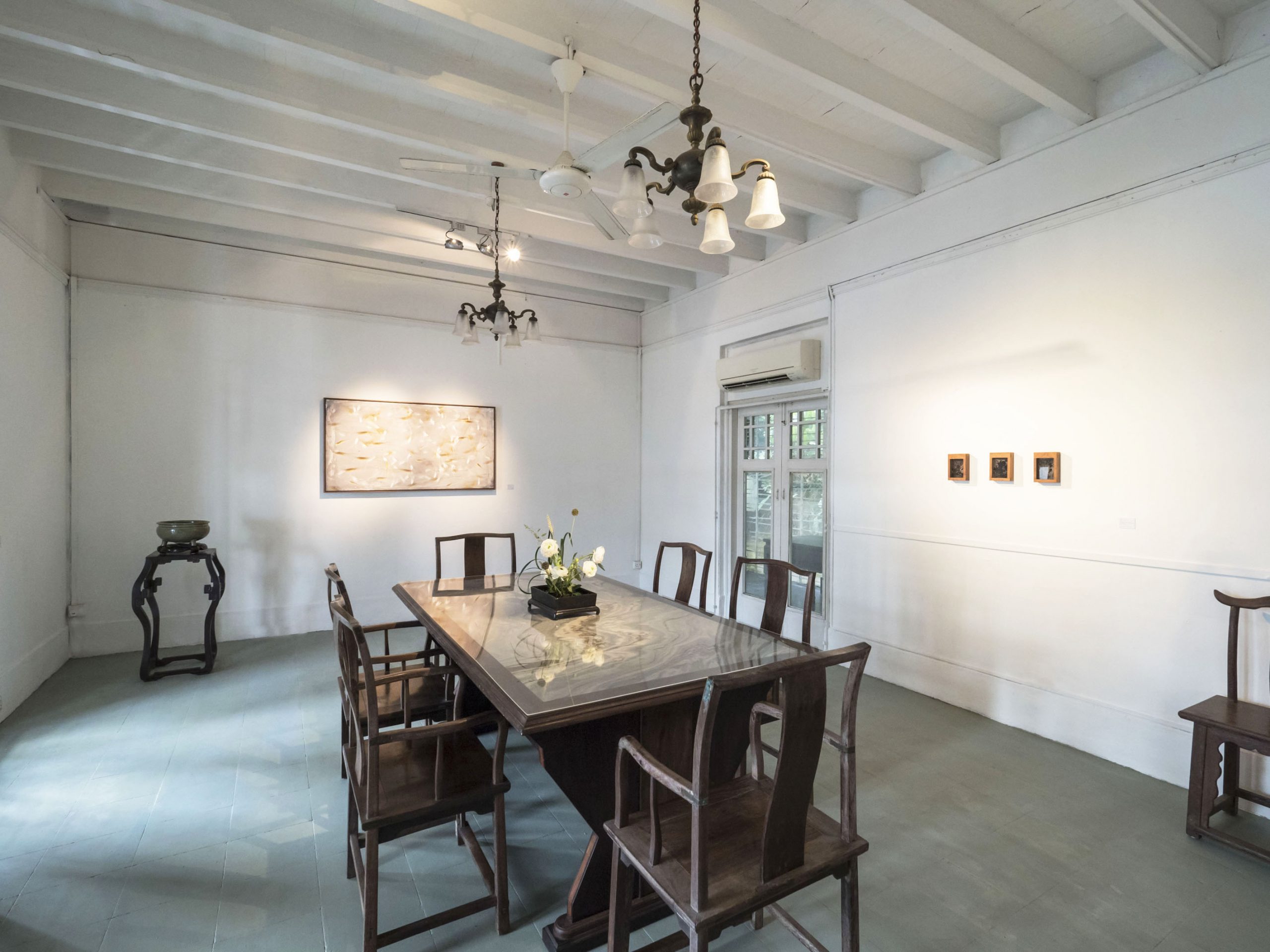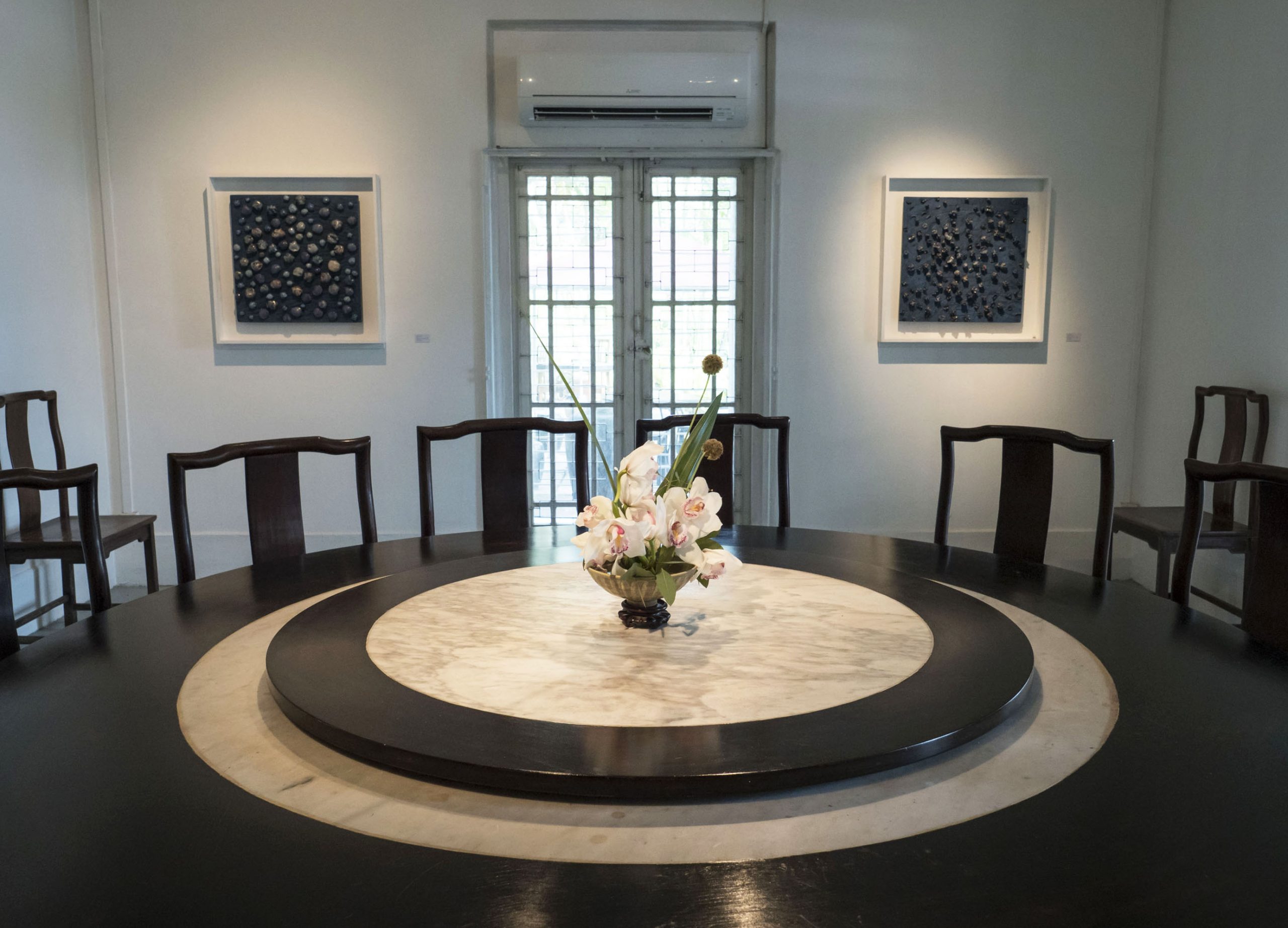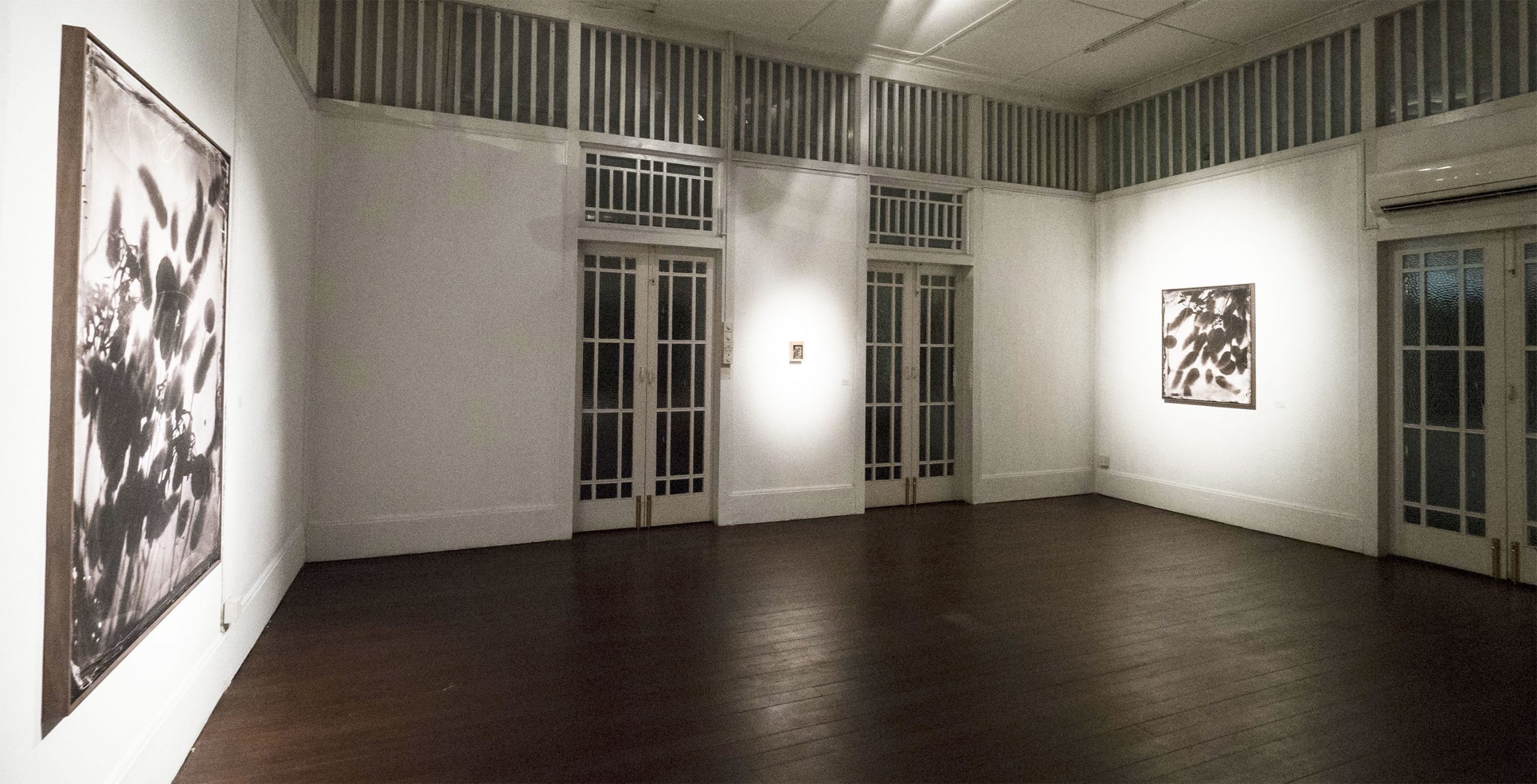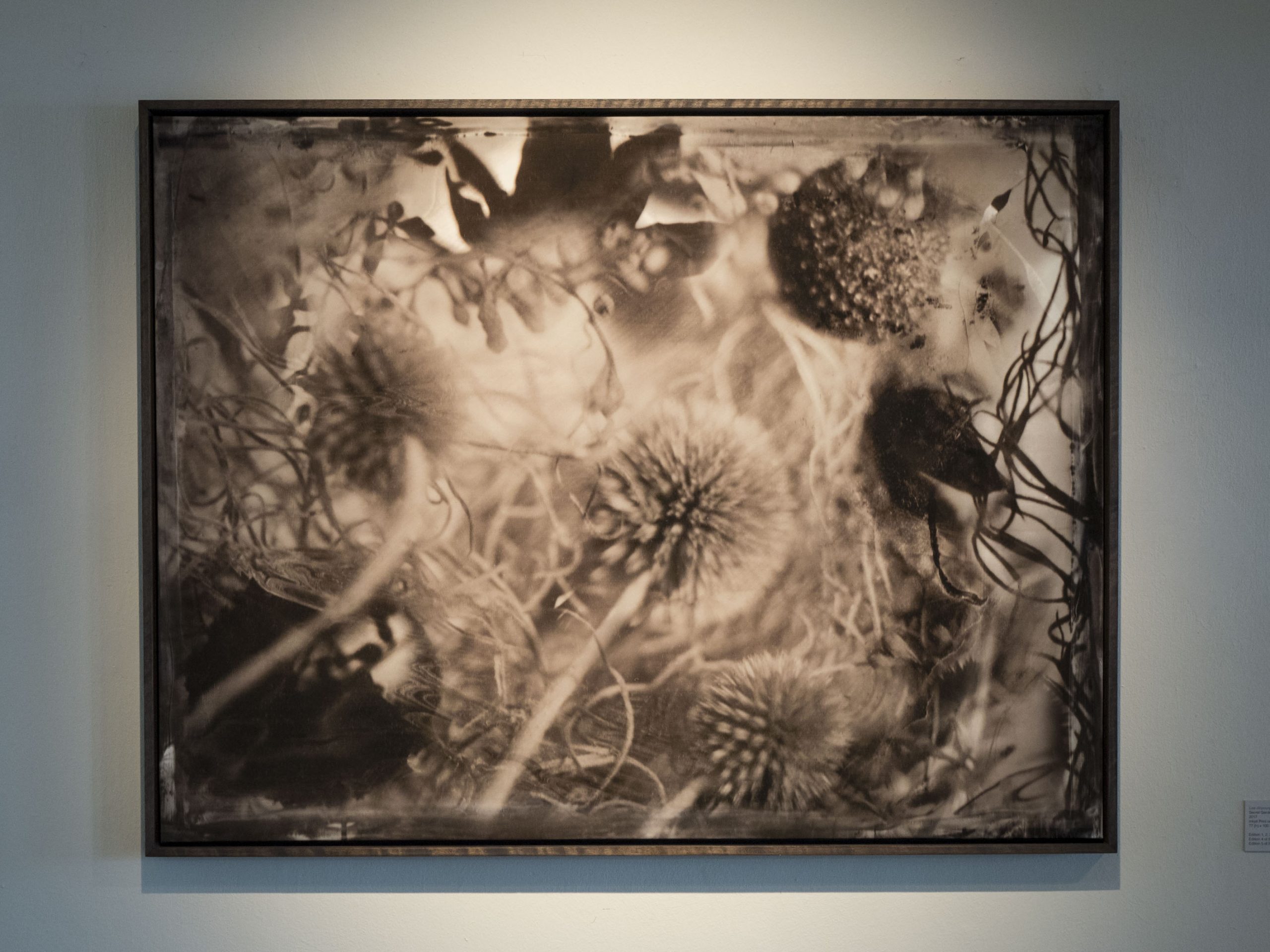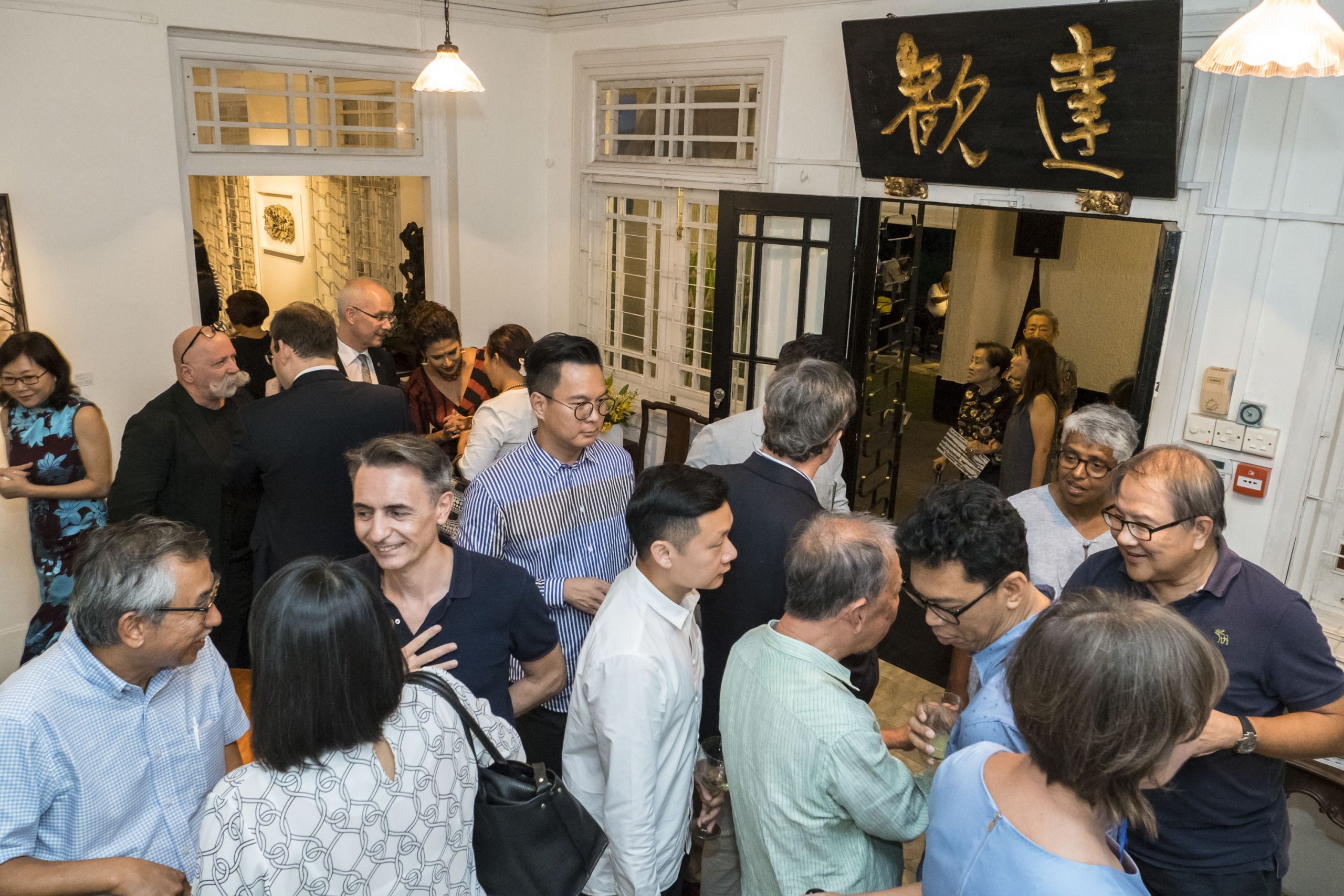Secret Garden
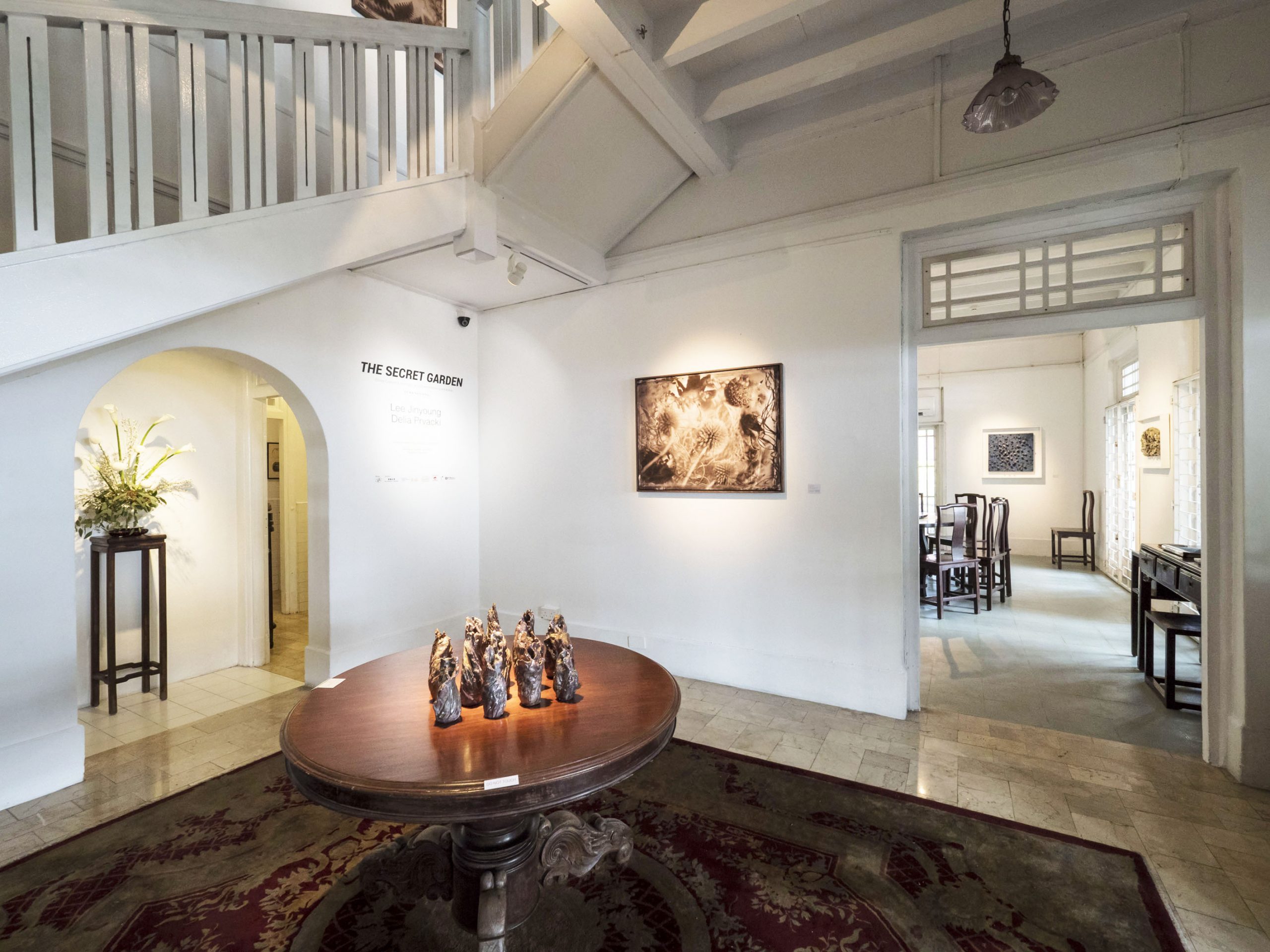
Lee Jin-Young’s Photography: a Painterly Synthesis
Lee Jin-Young is one of those rare photographers whose work makes us gently reinterpret the common definition of what photographic images are. Her photographs hold a plenitude of elements eliciting in our visual mind all that could have been made by hand in ink paintings or pencil drawings. If you are a painter looking at her work, your mental brush can actually trace the thick and thin lines, tiny irregular specks and darkish or greyish areas of Lee’s images. What is seen through the deep, narrow tunnel of the camera lens is not touched up digitally, but sensitively and creatively accepted with the workings of the natural.
The primary charm of Lee’s work comes from the effects of the wet collodion process, the 19th century photographic process that she has chosen as her working method. In the wet collodion process, the negative of the image is produced on glass which is coated with wet solution. The solution is poured and evenly spread onto the glass plate, and in the time when Lee places this glass-film into the holder and her camera, and while developing the images, unexpected ‘visitors’ silently invite themselves into her intended images – these are particles of dirt or dust that are floating in the air, and become caught in the syrupy solution. In other words, unintentional elements become a part of the intentional image-making: they naturally draw and form wavy or broken lines, making speckled marks sprinkled at random or which disturb the crisp contours of the objects.
All of these natural accidents, however, mingled with the desired image the artist initially wanted to capture, create a mysterious cocktail of flaws and normalcy in the entirety of the image. The definite shapes lose their clarity and are thus reconstructed to the obscure or even the abstract. Lee herself was deeply drawn to this kind of change and many viewers find her photographed image irresistible for this reason.
During her residency at Temenggong, she enjoyed observing lush, tropical greenery in the garden at different times of a day. She collected different types of leaves from the garden of Temenggong and brought them back to Seoul in order to use for her work. The works presented at this exhibition feature the dried fallen leaves of the Temenggong garden. Lee placed them on a lighted acrylic box, playing around with their positions at whim and changing the light to be weaker or stronger. At the same time she zoomed in to them as if to plunge right into the heart of the subjects. In The Secret Garden, viewers can enjoy multiple small works set in a wooden frame, all of which were made with the motif of dried leaves or flowers. This kind of glass photograph is called ‘ambrotype photograph’. Lee’s ambrotype photograph is essentially just the negative film of the photograph captured on glass. The encased glass negative, in its dainty size and filmic state, transmits a rare intensity. Her photograph is like a bijou residence of delicate images, away from anything excessively digitally edited.
Along with the petite pieces, viewers can also find Lee’s work in an enlarged format, printed on ‘hanji’ or Korean traditional paper. The enlargement and printing on this paper redefines Lee’s ambrotype photograph. The whole image looks as if it has been recast into a small space, slightly floating or trembling in the air or water – some twirling leaves even look like aquatic life. Lee Jin-Young comments:
“The feeling is of one going into the picture, just like in a Chinese landscape painting. You are inside it, rather than looking at it from outside at a distance.”
Somehow viewers are made to feel that they are inside the space where the captured image is residing, closely looking at its quivering presence shrouded in blurry delicate-ness.
The act of pressing the camera button equates with the desire of every passionate photographer who wants to encapsulate at a particular thrilling moment all that she or he sees and feels – all that surpasses physical sensations, the whole invisible architecture of air, wind, sunlight, shadow, color, movement and etc., concocted with your perceived emotional charge or social significance. That particular moment in life, however short-lasting, limited or humble, owns an authentic power that enables us to glimpse the fullness of life, rewarding our heart with the energy to go on with life.
There seems to be no way, unfortunately, to condense this immensity into a single live image. This is why we often experience silent disappointment at the photos taken, although all the relevant factors are recorded inside the images: people, objects or scenes at various ecstatic moments that punctuated that moment of life. Even with such thorough photographic inclusion of all that felt unique, the produced image frequently looks painfully pedestrian. But we all know such moments of perfection exist; it is just beyond our ordinary ability to re-narrate or re-present it. Artistic capability, no matter what medium the artist may work with, fulfills this rueful disparity between the human’s creative desire and its actual realization.
Lee Jin-Young’s photography does not show the crisp exactitude of what has been photographed. On the contrary, the image is overrun or intermingled with blurry riddles of water marks, streaks, dust or unidentifiable patches derived from natural elements during the process of making the photographs. Nonetheless, these rather accidental marks are not abrasive to the objects of the image – the petals, leaves of other floral features – they rather blend themselves with and complement the photographed objects. Perhaps such a host of intangible elements is what holds and fills our perception of her images. This delicate synthesis is the main factor of the aura of Lee’s ambrotype photograph that looks so naturally intricate. Lee’s artistic accomplishment lies in placing value to this kind of blending and fine-tuning the dialogue between the uncontrollable, natural elements of the working process and the intended, into the work of art. Art seems to be something neither conceptually nor physically controlled by the human on a meticulous level. It is born through the indefinable concoction of the artist’s manipulation of the medium and unfathomable inevitability caused by wider circumstances.
By observing and understanding her work, we learn how art can hone and complete our sensory confines, further deepening our consciousness of life. The way Lee creates the images with her ambrotype photography much reflects the way human life is lived; with conscious purpose and mindful effort, yet blended in with the inevitable or unescapable.
Kate Lim
Director of Art Platform Asia, Art Writer
The Secret Garden
“The artist has two options: to explain one’s own metaphysical approach through works, in which [the works] interpret the idea; or to create one’s own world, the meaning of which is established in the act of creating, and is materialised through the works of art. Delia Prvacki chose the second option. She creates her unique universe of forms having harmonious motives, logic, the way of surviving and development.”
In this exhibition, The Secret Garden, we see an interesting pairing of two different media presenting the theme. On the one hand, Lee Jinyoung uses the wet colloidon process to produce ambrotype photographs, (photography being a medium that occasionally paradoxically finds itself classed as “ephemera”), and on the other, Delia working in the ceramic medium (a medium which, while fragile in some instances, gives an impression of durability). Despite the surface variation in the two artists’ media of choice, the common ground of The Secret Garden is both artists’ deep and reflective engagement with the world around them, and forms the path in the Garden, upon which we meander and contemplate the works, and the artists’ expressions. In Jinyoung’s use of her means of expression, “taking a photo is the art of trying to adjust to the surrounding environment. … It works best for me to spend as much time as possible with the objects when I take a photograph. This allows me to broaden the scope of interaction with them… This kind of process becomes a source of creativity and it can also motivate other ways of expressing things.” This statement finds resonance with Delia’s artistic experience, “The immensity of sky, the mystery of ocean, the flow of rivers, the depth of forest… they are universal themes inspiring artists, musicians, writers and poets since primordial times and there is an infinity of forms of expression and ways of interpretation. For me, it is always about finding my own place and a sense of belonging…”
Delia’s Gardens
Beginning in the late 1980s, Delia’s art has often taken inspiration from nature, and her natural surroundings. Nature is also a leitmotif that re[sounds] in the story of Delia’s (and Milenko’s) “transplantation” from the former Yugoslavia to Singapore. Having recently emerged from personal loss and the experience of the tragedy of the conflict of the Balkans War and the breaking up of Yugoslavia, they arrived in Southeast Asia from 1991-1992.
If 19th century colonial governments facilitated the exchange of plants – not only removing specimens from the colonies for economic purposes, but also to bring plants from the metropolis to the colonies – allowing for colonial landscapes to be engineered and reshaped to become a ‘microcosm’ of ‘home’, Delia encountered plants she had previously only known as ‘imports’ in Europe (orchids, heliconia), in their native environments. Rather than to manipulate the surroundings to recreate the landscape they left, they began to add potted local plants to their first home in 1992. Moving next to a property with a garden from 1993-1997, allowed the natural surroundings to “organically” readjust Delia’s intellect, her senses, and, using the analogy, to lay down her roots here. Observations of cross-cultural similarities also helped Delia’s adaptation to her new environment: “Spring Awakening” recalls Delia’s first encounter of the fever of Chinese New Year preparations when she arrived in Singapore around early January in 1992. The pussy willow was the artist’s first impression of the new complex cultural milieu in which she now finds herself. The gentle branches of the Salix, with their silvering, silky buds were also part of ceremonial and ritualistic tradition still practiced in Delia’s native Northern Transylvania, and as in Chinese culture, they were the symbol of spring, of new arrival.
The Residency and the works
Delia’s impetus to participate in this residency at Temenggong was as much personal as it was artistic: between 1997 to 2015 she was living in a similar type of house. In her typical style of presentation, creating her “unique universe”, Delia approaches the exhibition as an installation. Her works and exhibitions are usually “site-specific” and it is key for her as an artist to respond to the space in the best and most expressive way, that will articulate – and integrate – both her work and the location itself. Within the setting of the Temenggong residence, Delia’s Secret Garden is not about the literal beauty of a landscape, or the symbolism and semiotic meaning of a particular type of plants, flowers, fruits. Rather, the artist wishes to express “the abundance and continuity of natural processes that defines the physical space for our human condition, in sublime unity and harmony.”
The concept behind this series of artworks combines the perpetual grousing, rejuvenation, and the omnipresence of vegetation in the climate and the space, as a metaphor for living in tropics. Unlike the “Triste Tropiques” Delia first encountered in the writings of Claude Levi-Strauss, the environment that she encountered upon arriving in Singapore – and in which she is now acclimatised – is one that is rich, lush, and colourful. The series of works presented here evoke the gradual shifting of the seasons: as the sculptures were created in the period approaching the Winter Solstice, waiting to be launched on the cusp of the Spring Festival, the massive and monumental “Spring Awakening” marks the end of Winter and the beginning of Spring. The sculptural forms of “Spring Awakening” are close representations of the organic appearance of the budding willow plant, capturing the entire process of its complete maturation cycle within a few months. The following sections with different versions of “Germination”, “Nursery” “Herbarium (Foliage)” reflect the annual stages in the life-cycle of a plant. “Hybrid” is presented as an imaginative garden of ‘surprises’, in its name evoking the creative possibilities of cross-pollination, and visually, as “vertical gardens”, greenery reaching up towards the light of the sun. In “Roof Garden”, Delia brings together discarded roof tiles from her previous home that was a black-and-white bungalow similar to those at Temenggong, and conceptual elements reminiscent of the stars featured in a series known as the “Piece of Sky”. The combination marries the living space with the skies, and together with the sculptures that are now installed in the various rooms and spaces of the interior of the house in Temenggong, express the constant that is in Delia’s practice: the intention to raise an “awareness about our own human destiny and configuration within a given space.” In this way, her “Secret Garden” continues to be, as described by Svetlana Isakovic, a “unique universe of forms having harmonious motives, logic, the way of surviving and development.”
The exhibition cited afore, de Rerum Natura, featured forms and shapes of plants and foliage antecedent to those revisited from time-to-time (such as in the joint exhibition with her husband Milenko at the Lasalle-SIA college of the Arts in 1993), and evoked by Delia in the works in this this residency. The resurgence of the natural motif in her creation reflects the cycle of seasons – plants bloom, leaves fall, and every spring, they bud again in new ways. Recasting temporal foliage and blooms into sculpture is a very physical process, both in the act of creating, and in the outcome. While The substance, and the ‘substantiality’ of the artist’s created universe seemingly paradoxically renders permanent particular moments in the life cycle of plants – installing them in situ in specific spaces seemingly fixating the “garden” even more so – this “anchoring” in fact addresses “the perennial renewal and eternal duration of natural cycles, and is a point of orientation to Nature’s flow of sequences in the modality of Delia’s practice.
Chang Yueh Siang
Art Historian


